West Coast, New Zealand
| West Coast Te Tai Poutini | |
|---|---|
| Region | |
 | |
| Coordinates: 42°36′S 171°24′E / 42.6°S 171.4°ECoordinates: 42°36′S 171°24′E / 42.6°S 171.4°E | |
| Country | New Zealand |
| Island | South Island |
| Constituent territorial authorities | |
| Government | |
| • Type | Regional council |
| • Body | West Coast Regional Council |
| • Chair | Andrew Robb |
| Area | |
| • Total | 23,276 km2 (8,987 sq mi) |
| Population (June 2016)[1] | |
| • Total | 32,600 |
| • Density | 1.4/km2 (3.6/sq mi) |
| Website |
wcrc |
The West Coast (Māori: Te Tai Poutini) is a region of New Zealand on the west coast of the South Island, one of the more remote and most sparsely populated areas of the country. It is administered by the West Coast Regional Council. At the territorial authority level, the region comprises Buller District, Grey District and Westland District. The principal towns are Westport, Greymouth and Hokitika.
Naming
The name Westland is used by some New Zealanders to refer to the whole of the West Coast, including Grey District, Buller District and Fiordland, and can also refer to the short-lived Westland Province of 1873–76.
Fiordland is on the west coast, but is in the Southland Region rather than the West Coast Region.
Inhabitants of the West Coast are colloquially known as "Coasters".[2][3]
Geography
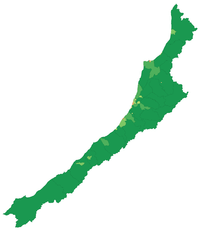
The region reaches from Kahurangi Point in the north to Awarua Point in the south, a distance of 600 km. To the west is the Tasman Sea (which like the Southern Ocean can be very rough, with four-metre swells common), and to the east are the Southern Alps. Much of the land is rugged, with a coastal plain where much of the population resides.
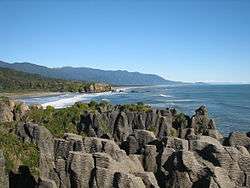
The land is very scenic, with wild coastlines, mountains and a very high proportion of native bush, much of it native temperate rain forest. It is the only part of New Zealand where significant tracts of lowland forest remain: elsewhere, for instance on the Canterbury Plains and in the Firth of Thames, they have been almost completely destroyed for settlement and agriculture. Scenic areas include the Haast Pass, Fox and Franz Josef Glaciers, the Pancake Rocks at Punakaiki and the Heaphy Track.
The region has a very high rainfall due to the prevailing northwesterly wind pattern and the location of the Southern Alps, which give rise to heavy orographic precipitation. The rain shadow effect is responsible for the relatively arid climate of the Canterbury Plains on the other side of the Southern Alps.
The region's area is 23,276 km2. It is divided into the three districts of Buller, Grey and Westland.
Economy
Industries on the West Coast include mining for coal and alluvial gold, forestry and wood processing, and also fishing (including whitebaiting), tourism and farming. Dairy farming has grown strongly - the local dairy co-operatives Westland Milk Products remained independent when most others merged to form Fonterra in 2001. Other industries are the manufacturing and sales of greenstone jewellery, sphagnum moss gathering and stone-collection for garden landscaping.
The sub-national GDP of the region was estimated at US$779 million in 2003, 1% of national GDP.[4]
History
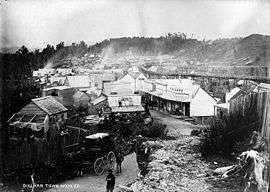
The region is home to Māori, who valued it for the greenstone (pounamu) found there in abundance.
The region was only occasionally visited by Europeans until the discovery of gold near the Taramakau River in 1864 by two Māori, Ihaia Tainui and Haimona Taukau. By the end of the year there were an estimated 1800 prospectors, many of them around the Hokitika area, which in 1866 was briefly the most populous settlement in New Zealand.
The region was divided between Nelson Province and Canterbury Province from 1853: in 1873 the Canterbury portion of the region formed its own province, the Westland Province, until the abolition of the provincial system in 1876.
The West Coast Gold Rush between 1864 and 1867 created numerous gold rush towns such as Okarito, which at one time was the largest town on the West Coast but quickly almost vanished as miners moved on. After that time, the population dwindled, but the main towns that still exist had become established.
Following greenstone and gold, the next valuable mineral was coal. Discovered near the Buller River in the mid-1840s, mining began in earnest during the 1860s. By the 1880s coal had become the region’s main industry, with mines throughout the northern half of the region, especially around Westport. Many of these continued in operation until the mid-20th century, and several survive.
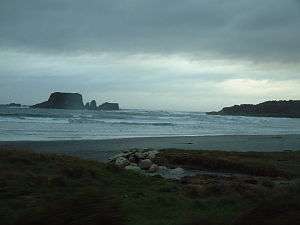
Timber has also long been a major industry, although in recent years there has been an uneasy balance between forestry for wood and forestry for conservation. Much of the region is public land administered by the Department of Conservation and the region has some of the best remaining stands of native forest, along with a wealth of rare wildlife. Ecotourism is now an important industry, and this goes hand in hand with the conservation efforts.
Habitation
Population
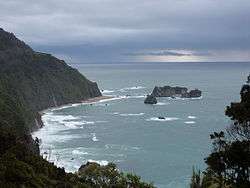
The region is sparsely populated, especially in the south, with the 2006 census recording 31,326 inhabitants, up from 30,303 in 2001, lower than the 1996 figure. The June 2016d population is 32,600.[1]
There are only four towns with a population over 1,000: Greymouth, Westport, Hokitika and Reefton. During the gold rush days, Hokitika had a population of more than 25,000 with more than 100 pubs. A recreation of an early New Zealand settlement is at Shantytown.
| Urban area | Population (June 2016)[1] |
% of region |
|---|---|---|
| Greymouth | 9,750 | 29.9% |
| Westport | 3,970 | 12.2% |
| Hokitika | 3,600 | 11% |
| Reefton | 990 | 3% |

Industries include mining for coal and alluvial gold, forestry and wood processing, fishing (including whitebaiting), tourism and farming. Dairy farming has grown strongly – the local dairy co-operative Westland Milk Products remained independent when most others merged to form Fonterra in 2001. Other industries are the manufacturing and sales of greenstone jewellery, sphagnum moss gathering and stone-collection for garden landscaping. Monteith's brewery is in Greymouth. The region had one of the strongest growing regional economies of New Zealand in 2007,[5] though from a rather small base.
The region has been included in the "Top 10 Coastal Drives of the World" by Lonely Planet.[6]
Flora and fauna
The region has the only New Zealand nesting place of the kotuku (white heron), near Okarito Lagoon, visited by tours from the small farming township of Whataroa. This rare bird appears on the $2 coin.[7]
See also
External links
| Wikivoyage has a travel guide for West Coast (New Zealand). |
| Wikimedia Commons has media related to West Coast Region. |
- West Coast Regional Council
- Tourism West Coast and Development West Coast
- Map (1900s) of West Coast
- "West Coast Conservation Management Strategy Volume 1 2010-2020". Department of Conservation. 2010.
- West Coast Marine Protection Forum
References
- 1 2 3 "Subnational Population Estimates: At 30 June 2016 (provisional)". Statistics New Zealand. 21 October 2016. Retrieved 21 October 2016. For urban areas, "Subnational population estimates (UA, AU), by age and sex, at 30 June 1996, 2001, 2006-16 (2017 boundary)". Statistics New Zealand. 21 October 2016. Retrieved 21 October 2016.
- ↑ West Coast – Regional Information (from 'New Zealand Tourism Online' website)
- ↑ The West Coast New Zealand (from 'A New Zealand Travel Guide' website)
- ↑ "Regional Gross Domestic Product". Statistics New Zealand. 2007. Retrieved 18 February 2010.
- ↑ History (from the Buller District Council website)
- ↑ "West Coast, New Zealand official site: Find activities, accommodation, events". Westcoastnz.com. Retrieved 2012-10-16.
- ↑ New Zealand Coinage Specifications (from the Reserve Bank of New Zealand website. Accessed 2008-03-26.)